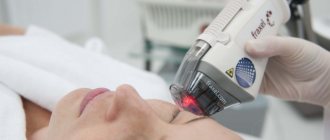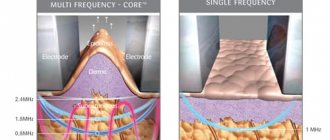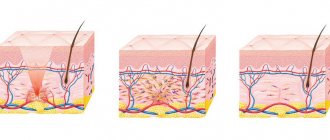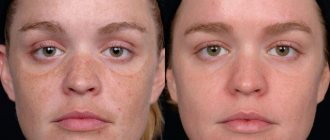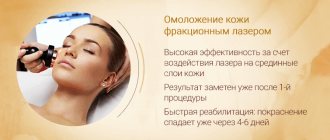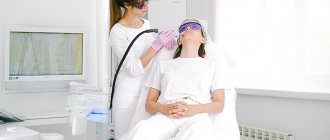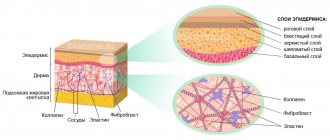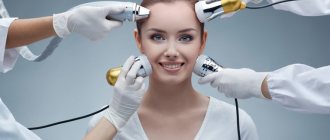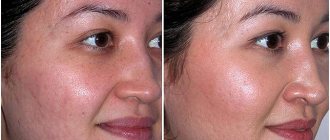From this article you will learn:
- RF face lifting: what is it, reviews,
- thermolifting, facial thermage – reviews from cosmetologists, photos.
RF lifting (English: Radiofrequency) is a technology for non-surgical tightening of skin that has the first signs of aging. In Russia, this procedure is often called thermage or thermolifting. This procedure is ideal for those who (due to their still young age) do not want or do not trust surgical rejuvenation procedures.
Radiofrequency energy in cosmetology is used to treat sagging skin, face lifting and is best suited for patients aged 30-45 years, who still have a high level of production of their own collagen. The most famous devices for RF lifting are: “Thermage”, “Accent”, “Pelleve”, “Tripollar”.
RF lifting: indications
1) loose skin on the face, neck, arms or abdomen, 2) the desire to get rid of cellulite, 3) non-surgical correction of bags under the eyes, 3) changing the contours of the face and neck.
RF face lifting is most often performed for the following areas –
- forehead (eyebrow lifting and forehead skin tightening),
- cheeks (the skin is slightly tightened and enlarged pores are reduced),
- jawline (folds are reduced and sagging skin is tightened),
- neck (skin tightens, double chin decreases),
- area under the eyes (the skin thickens and tightens, the size of bags under the eyes decreases due to the burning of fatty hernias),
Important : It should be noted that RF lifting reviews from the developers of the method indicate that if you need to increase skin elasticity, then this technique is only suitable for skin that has only the initial signs of aging, and in which the process of producing its own collagen is still quite strong. If you are interested in burning fat deposits, or you want to get rid of cellulite, then the age of your skin does not matter.
RF face lifting – what is it?
As we have already said: RF lifting uses radio frequency energy. Technically, radio frequency is a certain number of oscillations (waves) per second of electric and magnetic fields in the radio wave portion of the electromagnetic spectrum. Electromagnetic waves can be generated using voltage and emitted into space in the form of radio waves through an antenna or electrode.
What happens in the skin when exposed to radio frequency energy - according to the developers of the method - RF lifting causes microscopic changes in tissue, followed by remodeling of new collagen, as a result of which subcutaneous structures are improved and tightened. At the same time, during the procedure the texture of the upper layers of the skin is not affected and practically does not change in any way, i.e. You should not expect any smoothing of wrinkles.
An increase in temperature leads to contraction (shrinkage) of collagen-containing tissues. When the maximum operating temperature of 44-50 degrees is reached, even the fibrils inside the collagen fibers themselves are compressed. At this temperature, collagen fibers lose water, denature, shrink and, most importantly, lose their ability to stretch, which leads to increased skin elasticity.
According to the developers of the method and cosmetologists, RF lifting not only compresses collagen fibers, but also stimulates the production of one’s own collagen, which should lead to an increase in the level of collagen content in tissues. However, as you will see further, there is simply no objective evidence that there is also an increase in the amount of collagen.
How RF lifting works: video
Radio facelift
The maximum possible anti-age effect
: the structure and condition of the skin significantly improves, it becomes smooth, toned and youthful.
Radiolifting effectively fights scars, scars, acne marks and blackheads.
Radiolifting is most effective in the fight against a double chin!
Another advantage of the action of radio waves is the increase in the rejuvenation effect after completion of the course of sessions. The duration of the effect increase is about six months.
Make an appointment
RF lifting – how the procedure works
Before the procedure -
Before RF lifting, the skin of the face or body must be thoroughly cleaned with soap and water to remove any remnants of cosmetics, creams or oils that may affect the quality of the procedure. Sometimes before the procedure, a special anesthetic cream is applied to the skin to numb the skin. After a certain time, immediately before the procedure, this cream is washed off by the cosmetologist with an alcohol-containing solution.
Depending on the device used and the experience of the esthetician, special markings may be applied to the skin to ensure even coverage of RF (radio waves) and to prevent accidental overlap of treatment areas.
Depending on the device used, a special pad may or may not be used and placed on the patient's abdomen or under the back. This pad is necessary for grounding (most often used for monopolar devices). Again, depending on the device used, a special gel may be used to act as a barrier between the surface of the patient's skin and the tip of the RF device.
During the procedure -
The cosmetologist moves the tip of the device over the surface of the skin, while radio frequency energy heats the skin in the range of 40 to 44 degrees Celsius, maintaining this temperature for some time. The heat produced has a positive effect on the lymphatic and vascular system and increases the flow of fluid to the cells.
Heating the inner layers of the skin causes microscopic changes in the tissue and an initial reduction in collagen, which promotes subsequent collagen remodeling over the next few months.
RF lifting: video
After the procedure -
A soothing gel or lotion may be applied to the skin. Immediately after the RF face lifting procedure, reviews show that patients feel skin tightening, which gradually increases over the next 1-2 months.
The result after the procedure - RF lifting - reviews from most patients confirm that the result is noticeable for up to several years. If minor changes are necessary, just 1 procedure may be sufficient (most often after the Thermage 4 device, which is by far the most advanced and effective). However, if more significant changes in skin condition are needed and/or the patient has significant skin thickness, then the cosmetologist may offer a series of 2-6 procedures performed every 1-3 weeks.
RF face lift: before and after photos
RF body lifting: before and after photos
Contraindications for use
Despite the relative safety of radiofrequency exposure, it has a number of limitations for use for certain categories of patients.
Absolute contraindications include:
- low-quality neoplasms;
- pregnancy, regardless of duration;
- diseases of the cardiovascular system;
- immunodeficiency in any form;
- acute infectious diseases;
- skin diseases (psoriasis, lupus erythematosus, eczema, scleroderma);
- fresh scars after surgery and scars;
- silicone inserts in the affected area.
It is strictly prohibited to use radio frequency currents on patients with metal implants and pacemakers.
As for relative contraindications, these include exacerbation of acne and chronic skin diseases.
Devices for RF lifting – which one is better?
There are a wide variety of devices that deliver radiofrequency energy to treat a variety of skin problems. However, many of them are not approved for use and may therefore be harmful. Below we will look at the most common devices approved by the FDA (the world's most famous medical organization for quality control of medications and treatment methods).
What you need to pay attention to when choosing a device for RF lifting...
- Different devices operate at different frequencies - for example, there are devices that operate at a frequency of 470 kHz (that's 470 thousand pulses per second).
There are those that operate at 4 MHz or 6 MHz (4 or 6 million pulses per second, respectively). There are many other devices, but usually the pulse frequency does not exceed 9 MHz. The higher the pulse frequency, the deeper the effect of the device is carried out deep into the tissues. Therefore, for the method to be effective, the device must first of all have high power. However, this can lead to overheating of the epidermis (the surface layer of the skin). Therefore, it is very important that the device is equipped with sensors for monitoring the temperature of the epidermis, as well as a cooling system. Such devices are usually much more expensive than low-frequency ones. The latter do not require either sensors or cooling systems, and therefore their price is much lower (as is their efficiency).
- Device operating modes – RF lifting devices can operate in two modes. Firstly, radio frequency energy can be delivered in a monopolar mode, which is capable of treating areas larger than the device head itself, and the energy penetrates 20-30 mm deep. This is the second very important point that allows you to achieve a good effect from the procedure.
Secondly, there are devices that operate in bipolar mode. With it, the penetration depth of radio frequency energy is extremely small (only 2-3 mm), which means that the energy practically does not penetrate into the dermis, limiting its effect on the epidermis (24stoma.ru). Bipolar devices are more convenient to use for cosmetologists themselves, but are less effective in terms of results.Conclusions : if you want a guaranteed result (especially for cellulite), then we advise you to choose procedures only on a device with a monopolar mode with a high pulse frequency. If you need to remove a double chin or change the contour of your face by burning excess fatty tissue, then devices with a monopolar mode will also be more suitable for you. But if you need to increase skin elasticity, then the bipolar mode will be preferable.
Thermage device –
The Thermage device operates in monopolar mode, has a pulse frequency of 6 MHz, and also uses patented ThermaTip technology to penetrate radio frequency energy into the deep layers of the skin (dermis). Heating the deep collagen structures in the skin results in immediate skin tightening. There are four generations of Thermage devices, and the most effective of them is Thermage 4.
Facial Thermage (popularly called thermolifting) was approved by the FDA in 2002 as a non-invasive procedure for use around the eyes and eyelids to treat fine lines and wrinkles, and to temporarily improve cellulite (in combination with vibration).
Note that the concept of “thermage” has become a household word among patients, and no longer implies the name of the device (as it should have been), but the procedure itself, carried out using any radio frequency energy devices.
Device “Accent” –
The Accent system has two tips at once - a bipolar tip for volumetric heating of the skin, that is, mainly for tightening the skin, and a monopolar tip for penetrating radio waves into the deep layers of the skin to reduce fatty tissue in the fight against cellulite.
Device "Tripollar" (Tripollar) –
The Tripollar system can use both monopolar and bipolar types of effects on the skin. It should be noted that when treating facial skin, bipolar devices allow you to achieve better results with less pain. In addition to professional devices, there are “Tripollar” devices for home use, the price of which starts at approximately $550.
But if we talk about RF body lifting, reviews among patients with initial signs of cellulite are positive only if the procedures are performed with devices with monopolar effects. This is due to the fact that from a monopolar tip the waves penetrate much deeper into the skin, which is important for the treatment of cellulite.
Combined devices –
Time does not stand still and device manufacturers in the beauty industry have begun to use radio frequency energy combined with other types of energy. This has provided many more options for treating a wide range of skin problems on the face and body. Typically, the energy of high-frequency light pulses is combined with radio frequency energy
Combined systems include the following devices:
- "Syneron" and "The Aurora" (pulsed light + RF),
- "Polaris", "Comet" (diode laser + RF),
- "VelaSmooth" and "VelaShape" (infrared light + RF),
- "Aluma" (vacuum booster + RF).
The combination of pulsed light (IPL) + radiofrequency energy (RF) in the machines is used for facial rejuvenation procedures, and the technology itself is called “Elos”. By the way, this combined technology is used not only to correct age spots and age spots on the skin, but also to epilate unwanted hair.
Features of radio wave technology
The main reason for skin aging is the delamination of collagen fibers, which tighten the epidermis and maintain its shape. This is a normal phenomenon associated with aging. Flabbiness begins to appear at the age of 35 with a tendency to further development. No cosmetic procedures can eliminate skin stretching, since its matrix itself is damaged. Radio wave lifting can restore it without interfering with the body. Today, many people still do not know what it is, since this technique is relatively new.
RF is an acronym for Radio Frequency, which means electrical impulses in the radio frequency range. Electric current penetrates deep into the skin and heats it throughout its entire thickness to 55-60ºС. When collagen and elastin are heated, proteins fold, which are the basis of the composition of these substances. Dense spirals of collagen molecules create a strong and elastic lifting frame.
Electricity in the radio frequency range helps activate the lipolysis process. This leads to the fact that fat deposits are decomposed into substances that are safe for the body - fatty acids and glycerol. They travel through the main bloodstream to the liver, where they are completely broken down and excreted from the body.
As a result, a double effect is achieved - tightening sagging skin and eliminating cellulite. Strengthening the skin can only be done in cases where the body is still able to start regenerative processes. You should also know that radiofrequency exposure is carried out only on the deep layers of the skin. Its surface will remain unchanged. RF lifting is not intended to eliminate wrinkles, age spots and other surface defects.
RF lifting – reviews, effectiveness studies
We can definitely say that RF lifting is effective in increasing skin elasticity by compressing collagen-containing structures and treating cellulite (especially if RF is combined with vibration effects on tissue).
You can also change the contour of your face and neck by destroying excess subcutaneous fat (for example, getting rid of a double chin), as well as reducing bags under your eyes. What you can't do - You can't get rid of wrinkles with this method, don't even try. There are many statements by cosmetologists about increasing the production of one’s own collagen after RF lifting, but no objective methods for assessing the increase in collagen in the skin after RF lifting have been provided in any clinical study.
The only objective method for evaluating any cosmetic procedure aimed at increasing the collagen content of the skin is to take skin samples before and after the treatment. After this, histological sections of the skin are studied under an electron microscope, which makes it possible to clearly say whether an increase in collagen content occurs or does not occur after the exposure.
We specifically searched for published clinical studies on the effectiveness of RF lifting that have such an evidence base. At the moment (January 2016) there is not a single study that has such an objective evidence base, which clearly indicates that statements about stimulating collagen production after RF lifting are unproven.
Two important points -
1) Firstly, the developers of the method talk about an increase in the level of collagen in the skin after RF lifting, which in itself can be verified only after studying electron microscopy data of skin sections before and after exposure. However, the developers do not publish not only electron microscopy images of skin sections, but even data on the quantitative increase in collagen before and after the procedure as a percentage.
By analogy with other methods, where developers usually suppress quantitative data on increasing the level of collagen in the skin (we are talking about plasma lifting, mesothreads) - this should indicate that the level of collagen, if it increases, then this happens either slightly or even at the level statistical error.
2) Secondly, many works have been published proving the effectiveness of RF lifting, but they are all based on completely subjective assessment methods, i.e. on a survey of patients or on a visual analysis of photos before and after RF lifting procedures. Such assessment methods, although subjective, confirm that changes are occurring. But the fact is that these changes occur due to compression of the collagen structures of the skin, and this is not even discussed. But this absolutely cannot be evidence of an increase in collagen content in tissues.
Although, the data from these surveys do not have much clinical value - below we will still present some numbers...
Data from published clinical studies - in 2013, a study was published on the effectiveness and satisfaction of patients after the RF lifting procedure (link to the study). The study involved 45 women with signs of aging skin and (in particular) visible wrinkles on the face. Each woman received 4 weekly RF lifting treatments. Then, after 1 and 6 months, they were surveyed and examined by cosmetologists.
RF lifting - reviews from these women showed that overall satisfaction with the procedure was only about 33.3% one month after the procedure and about 47% after 6 months after the procedure. Partial satisfaction was 53% one month after the procedure and 31% 6 months after the procedure. 8.9% were not at all satisfied with the RF face lifting procedure one month after the procedure and 4.4% after 6 months.
Again, the study does not indicate what exactly the therapy was carried out: bags under the eyes, wrinkles, reduction of the double chin or fatty deposits in the cheek area, and what exactly caused patient satisfaction. For example, can you notice a reduction in wrinkles around the eyes after RF lifting in Fig. 17? But removing the double chin (Fig. 18) and giving elasticity to the skin (Fig. 19) are very noticeable.
RF lifting: before and after photos
CONCLUSIONS: How convincing the evidence base for RF lifting is is up to you to decide. For our part, we have presented all the available arguments to confirm the effectiveness of the method, as well as data that may indicate the dubiousness of some of the declared effects. In addition, in cosmetology there are many absolutely ineffective methods, but which are actively promoted by cosmetologists.
For example, there is a method of facelift using mesothreads. The developers also say that these threads stimulate the production of collagen in the skin. However, studies have shown that there is no trace of any increase in collagen, and the tightening effect is carried out purely mechanically (due to hooks and notches on the threads), as well as due to tissue scarring along the inserted thread.
Facial Thermage - reviews from cosmetologists indicate that this non-invasive facelift procedure is very effective for skin with the first signs of aging. But on the other hand, cosmetologists are an interested party and it is important for them to sell as many services as possible, especially if a clinic buys an expensive device, then no one will refuse to use it, even if it is ineffective. In cases where it is necessary to sell an ineffective method, cosmetologists usually try to impose a combination of methods, one of which will actually have an effect.
For example, to smooth out wrinkles, cosmetologists often recommend a method called plasma lifting, but they do it to their patients mainly only in combination with Botox or with fillers (hyaluronic acid gels), which smooth out wrinkles without any platelet-rich plasma.
History of the method
The technique came to the world of cosmetology from physiotherapy. Here are the main stages of using radio frequency techniques.
- Second half of the 19th century - inventor Nikola Tesla first tried high-frequency currents on himself, followed by physiotherapeutic use.
- 1908 - scientists R. Tseynik and F. Nagelschmidt introduced the concept of “diathermy”.
- 1926 - discovery of UHF - a new healing field with therapeutic effects.
- 1980s USA - invention of the first radio frequency device.
- 2001 - creation of the Thermage method.
- Since 2004 - progressive production of ThermaCool, Melody, Aluma devices and other devices for aesthetic effects on dermal and hypodermal structures.
